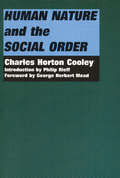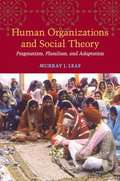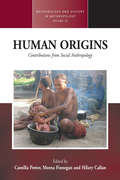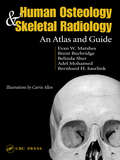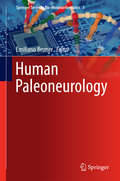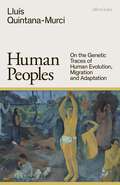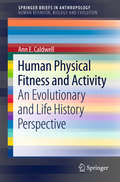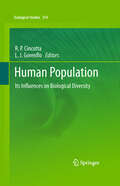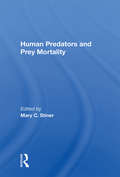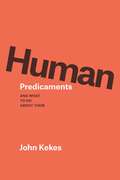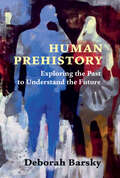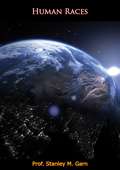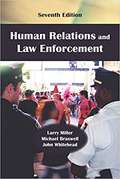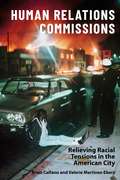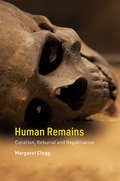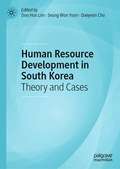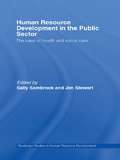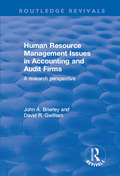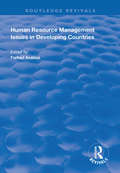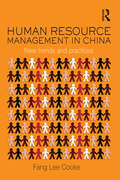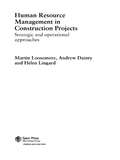- Table View
- List View
Human Nature and the Social Order
by Charles Horton CooleyThis work remains a pioneer sociological treatise on American culture. By understanding the individual not as the product of society but as its mirror image, Cooley concludes that the social order cannot be imposed from outside human nature but that it arises from the self. Cooley stimulated pedagogical inquiry into the dynamics of society with the publication of Human Nature and the Social Order in 1902. Human Nature and the Social Order is something more than an admirable ethical treatise. It is also a classic work on the process of social communication as the "very stuff" of which the self is made.
Human No More
by Michael Wesch Neil L. WhiteheadTurning an anthropological eye toward cyberspace, Human No More explores how conditions of the online world shape identity, place, culture, and death within virtual communities. Online worlds have recently thrown into question the traditional anthropological conception of place-based ethnography. They break definitions, blur distinctions, and force us to rethink the notion of the "subject." Human No More asks how digital cultures can be integrated and how the ethnography of both the "unhuman" and the "digital" could lead to possible reconfiguring the notion of the "human." This provocative and groundbreaking work challenges fundamental assumptions about the entire field of anthropology. Cross-disciplinary research from well-respected contributors makes this volume vital to the understanding of contemporary human interaction. It will be of interest not only to anthropologists but also to students and scholars of media, communication, popular culture, identity, and technology.
Human No More: Digital Subjectivities, Unhuman Subjects, and the End of Anthropology
by Michael Wesch Neil L. WhiteheadTurning an anthropological eye toward cyberspace, Human No More explores how conditions of the online world shape identity, place, culture, and death within virtual communities. Online worlds have recently thrown into question the traditional anthropological conception of place-based ethnography. They break definitions, blur distinctions, and force us to rethink the notion of the "subject." Human No More asks how digital cultures can be integrated and how the ethnography of both the "unhuman" and the "digital" could lead to possible reconfiguring the notion of the "human." This provocative and groundbreaking work challenges fundamental assumptions about the entire field of anthropology. Cross-disciplinary research from well-respected contributors makes this volume vital to the understanding of contemporary human interaction. It will be of interest not only to anthropologists but also to students and scholars of media, communication, popular culture, identity, and technology.
Human Organizations and Social Theory: Pragmatism, Pluralism, and Adaptation
by Murray J. LeafIn the 1930s, George Herbert Mead and other leading social scientists established the modern empirical analysis of social interaction and communication, enabling theories of cognitive development, language acquisition, interaction, government, law and legal processes, and the social construction of the self. However, they could not provide a comparably empirical analysis of human organization. The theory in this book fills in the missing analysis of organizations and specifies more precisely the pragmatic analysis of communication with an adaptation of information theory to ordinary unmediated communications. The study also provides the theoretical basis for understanding the success of pragmatically grounded public policies, from the New Deal through the postwar reconstruction of Europe and Japan to the ongoing development of the European Union, in contrast to the persistent failure of positivistic and Marxist policies and programs.
Human Origins: Contributions from Social Anthropology
by Hilary Callan Camilla Power Morna FinneganHuman Origins brings together new thinking by social anthropologists and other scholars on the evolution of human culture and society. No other discipline has more relevant expertise to consider the emergence of humans as the symbolic species. Yet, social anthropologists have been conspicuously absent from debates about the origins of modern humans. These contributions explore why that is, and how social anthropology can shed light on early kinship and economic relations, gender politics, ritual, cosmology, ethnobiology, medicine, and the evolution of language.
Human Osteology and Skeletal Radiology: An Atlas and Guide
by Evan W. Matshes Bernard JuurlinkHuman Osteology and Skeletal Radiology: An Atlas and Guide features nearly 700 photographs, line drawings, and radiographs demonstrating individual bones and collections of bones from a wide variety of detailed perspectives to aid in rapid identification of bone material. Intended as a handbook for those investigating skeletal remains, this atlas covers general and specific anatomic terms, includes comparative images of bones in photographic and radiographic form, and notes important comparisons among adult, juvenile, and fetal bones. It also provides a resource for those involved in gross anatomy and skeletal specimen laboratory study.
Human Paleoneurology
by Emiliano BrunerThe book presents an integrative review of paleoneurology, the study of endocranial morphology in fossil species. The main focus is on showing how computed methods can be used to support advances in evolutionary neuroanatomy, paleoanthropology and archaeology and how they have contributed to creating a completely new perspective in cognitive neuroscience. Moreover, thanks to its multidisciplinary approach, the book addresses students and researchers approaching human paleoneurology from different angles and for different purposes, such as biologists, physicians, anthropologists, archaeologists and computer scientists. The individual chapters, written by international experts, represent authoritative reviews of the most important topics in the field. All the concepts are presented in an easy-to-understand style, making them accessible to university students, newcomers and also to anyone interested in understanding how methods like biomedical imaging, digital anatomy and computed and multivariate morphometrics can be used for analyzing ontogenetic and phylogenetic changes according to the principles of functional morphology, morphological integration and modularity.
Human Peoples: On the Genetic Traces of Human Evolution, Migration and Adaptation
by Lluís Quintana-Murci'Masterful and ambitious. If you want to understand the power of population genetics in revealing the complex and diverse story of humanity, read this book' Tom HighamThe international bestseller and new Bible of population genetics: the science transforming our understanding of the past We are living through a revolution in knowledge. Over the past twenty years, genetics has shed light on the history of humanity in unprecedented ways. It enables us to study an individual's genome, compare it with populations worldwide, and understand its place in human history. Here Lluís Quintana-Murci, one of the scientists at the forefront of this research reveals how population genetics is transforming our understanding of who we are. Thanks to numerous discoveries, we now know how Homo sapiens spread around the world: from their exit from Africa approximately 60,000 years ago to the recent settlement of the remote lands of Polynesia within the last millennia. Population genetics has also shown that humans mixed with now-extinct species, including Neanderthals, enabling them to adapt to new environments and survive diseases. These cutting-edge genetic findings will shape our future too, offering the key to medicine tailored to individuals.But the greatest revelation of population genetics is that we are all mixed and the product of our ancestors’ long odyssey of migrations and adaptations across the globe. As Quintana-Murci explains, without diversity, without difference, there is no evolution. Filled with fascinating insights from the front line of research, Human Peoples is a pioneering guide to the ground-breaking science of our shared past.
Human Physical Fitness and Activity
by Ann E. CaldwellThe science of human physical activity and fitness is ripefor a novel theoretical framework that can integrate the ecological, genetic,physiological and psychological factors that influence physical activity inhumans. Physical inactivity dominates most developed nations around theworld, and is among the leading causes of disease burden and death worldwide. Despitethe wide array of physical and mental health benefits, few people get therecommended level of physical activity to achieve these benefits. Currentresearch on physical activity has not, as of yet, been successful for thedevelopment of effective exercise interventions. Several researchers haveadvocated a more integrative approach that takes evolutionary history intoaccount, but such a framework has yet to be advanced. To that aim, the firstgoal of this book is to present a comprehensive evolutionary and life historyframework that highlights the domain-specific aspects of the evolved psychologyand physiology that can lead to a more integrated and complete understanding ofphysical activity across the lifespan. It summarizes and extends previous workthat has been done to understand the ways natural selection has shaped physicalactivity in humans in traditional and modern economies and environments. In many ways, humans are adaptedto be physically active. Overall, however, natural selection has shaped aflexible, but energy conscious system that responds to environmental andindividual costs and benefits of physical activity to optimally allocate afinite energetic budget across the lifespan. This system is adapted to respondto cues of resource scarcity and high levels of obligatory physical activity, andconserves energy to favor allocation in ways that increase the likelihood ofreproductive success and survival. This nuanced application leads to a morethorough understanding of the circumstances that natural selection is predictedto favor both sedentary and active behaviors in predictable ways across thelifespan. The second goal of this book is to synthesizeand interpret cross-disciplinary research (from biological and evolutionaryanthropology and psychology; epidemiology; health psychology; and exercisephysiology) that can illuminate original approaches to increase physicalactivity in modern, primarily sedentary contexts. This includes a breakdown ofthe human lifespan to discuss the predicted costs and benefits of physicalactivity at each stage of life in order to differentiate the obstacles tophysical activity and exercise that are functionally adaptive--or were in theenvironments that they evolved--and identifying which factors are moremodifiable than others in order to develop interventions and environments thatare more conducive to physical activity. Normal 0 false false false EN-US JA X-NONE /* Style Definitions */ table. MsoNormalTable {{mso-style-name:"Table Normal"; mso-tstyle-rowband-size:0; mso-tstyle-colband-size:0; mso-style-noshow:yes; mso-style-priority:99; mso-style-parent:""; mso-padding-alt:0in 5. 4pt 0in 5. 4pt; mso-para-margin-top:0in; mso-para-margin-right:0in; mso-para-margin-bottom:10. 0pt; mso-para-margin-left:0in; line-height:115%; mso-pagination:widow-orphan; font-size:11. 0pt; font-family:"Calibri","sans-serif"; mso-ascii-font-family:Calibri; mso-ascii-theme-font:minor-latin; mso-hansi-font-family:Calibri; mso-hansi-theme-font:minor-latin; mso-bidi-font-family:"Times New Roman"; mso-bidi-theme-font:minor-bidi;}}
Human Population
by Richard P. Cincotta Larry J. GorenfloIn this volume the dynamic patterns of human density and distribution are examined in relation to the viability of native species and the integrity of their habitats. Social, biological, and earth scientists describe their models, outline their conclusions from field studies, and review the contributions of other scientists whose work is essential to this field. The book starts with general theories and broad empirical relationships that help explain dramatic changes in the patterns of the occurrence of species, changes that have developed in parallel with human population growth, migration and settlement. In the following chapters specific biomes and ecosystems are highlighted as the context for human interactions with other species. A discussion of the key themes and findings covered rounds out the volume. All in all, the work presents our species, Homo sapiens, as what we truly have been and will likely remain--an influential, and often the most influential, constituent in nearly every major ecosystem on Earth.
Human Predators And Prey Mortality
by Mary StinerDrawing from a wide variety of human societies and prey species, this book seeks to validate the importance of mortality studies for understanding modern and prehistoric human ecology. In a presentation that sets out to be both methodologically and theoretically innovative, the contributors combine archaeological and actualistic approaches with sea
Human Predicaments: And What to Do about Them
by John KekesIn his latest book, esteemed philosopher John Kekes draws on anthropology, history, and literature in order to help us cope with the common predicaments that plague us as we try to take control of our lives. In each chapter he offers fascinating new ways of thinking about a particular problem that is fundamental to how we live, such as facing difficult choices, uncontrollable contingencies, complex evaluations, the failures of justice, the miasma of boredom, and the inescapable hypocrisies of social life. Kekes considers how we might deal with these predicaments by comparing how others in different times and cultures have approached them. He examines what is good, bad, instructive, and dangerous in the sexually charged politics of the Shilluk, the Hindu caste system, Balinese role-morality, the religious passion of Cortes and Simone Weil, the fate of Colonel Hiromichi Yahara during and after the battle for Okinawa, the ritual human sacrifices of the Aztecs, and the tragedies to which innocence may lead. In doing so, he shakes us out of our deep-seated ways of thinking, enlarging our understanding of the possibilities available to us as we struggle with the problems that stand in the way of how we want to live. The result is a highly interesting journey through time and space that illuminates and helps us cope with some of the most basic predicaments we all face as human beings.
Human Prehistory: Exploring the Past to Understand the Future
by Deborah BarskyThis book provides a concise overview of human prehistory. It shows how an understanding of the distant past offers new perspectives on present-day challenges facing our species - and how we can build a sustainable future for all life on planet Earth. Deborah Barsky tells a fascinating story of the long-term evolution of human culture and provides up-to-date examples from the archaeological record to illustrate the different phases of human history. Barsky also presents a refreshing and original analysis about issues plaguing modern globalized society, such as racism, institutionalized religion, the digital revolution, human migrations, terrorism, and war. Written in an accessible and engaging style, Human Prehistory is aimed at an introductory-level audience. Students will acquire a comprehensive understanding of the interdisciplinary, scientific study of human prehistory, as well as the theoretical interpretations of human evolutionary processes that are used in contemporary archaeological practice. Definitions, tables, and illustrations accompany the text.
Human Programming: Brainwashing, Automatons, and American Unfreedom
by Scott SeliskerDo our ways of talking about contemporary terrorism have a history in the science, technology, and culture of the Cold War? Human Programming explores this history in a groundbreaking work that draws connections across decades and throughout American culture, high and low. Scott Selisker argues that literary, cinematic, and scientific representations of the programmed mind have long shaped conversations in U.S. political culture about freedom and unfreedom, and about democracy and its enemies. Selisker demonstrates how American conceptions of freedom and of humanity have changed in tandem with developments in science and technology, including media technology, cybernetics, behaviorist psychology, and sociology. Since World War II, propagandists, scientists, and creative artists have adapted visions of human programmability as they sought to imagine the psychological manipulation and institutional controls that could produce the inscrutable subjects of totalitarian states, cults, and terrorist cells. At the same time, writers across the political spectrum reimagined ideals of American freedom, democracy, and diversity by way of contrast with these posthuman specters of mental unfreedom. Images of such &“human automatons&” circulated in popular films, trials, travelogues, and the news media, giving form to the nebulous enemies of the postwar and contemporary United States: totalitarianism, communism, total institutions, cult extremism, and fundamentalist terrorism. Ranging from discussions of The Manchurian Candidate and cyberpunk science fiction to the cases of Patty Hearst and the &“American Taliban&” John Walker Lindh, Human Programming opens new ways of understanding the intertwined roles of literature, film, science, and technology in American culture.
Human Races
by Prof. Stanley M. GarnFirst published in 1961, this book provides a contemporary definition of race, the distinction between geographical, local and micro-races, as well as consideration of the major evolutionary mechanisms of race formation in man.Author Professor Stanley M. Garn was and remains a pivotal figure in the history of biological interpretations of race. He considered racial classification based on physical traits to be imprecise, and believed physical traits to be independent of each other, making classification by the assumption that a population shares certain traits incorrect. He also argued that racial classifications based on physical type seemingly elevated some physical traits to a racial status, but glossed over others, and concluded that racial classifications based on physical type can always be compartmentalized into smaller populations which share more physical traits in common.Thus, here in his book Human Races, he used three gradations of racial classification which were increasingly more specific in scope: geographical, local and micro.“Human Races is an attempt to describe what race is, and the mechanisms of racial differentiation in man. It will, I hope, help to dispel the antiquated notions of three “original” races, of the persistence of racial types, and of the role of undirected chance in bringing about racial differences. In their stead, I trust will emerge the contemporary picture of man’s genetic response to local selective factors, the constantly changing nature of the natural populations we call races.”—Author’s Preface
Human Relations And Law Enforcement
by Larry Miller Michael Braswell John WhiteheadLaw enforcement professionals encounter multiple challenges. The experiential case-study approach of Human Relations and Law Enforcement honed through seven editions places readers in hypothetical problem situations. Scenarios invite reflection and prompt a deeper understanding of the nature of law enforcement work. Concise but thorough introductions set the stage for thoughtful analysis of police-community relations, crisis intervention, interacting with juveniles, effective contact with the emotionally distressed, coping with stress, making ethical decisions, and administrative responsibilities. Case commentaries and questions stimulate discussion about possible courses of action and potential outcomes.
Human Relations Commissions: Relieving Racial Tensions in the American City
by Prof Valerie Martinez-Ebers Prof. Brian CalfanoDuring the 1950s, amid increased attention to the problems facing cities—such as racial disparities in housing, education, and economic conditions; tense community-police relations; and underrepresentation of minority groups—local governments developed an interest in “human relations.” In the wake of the shocking 1965 Watts uprising, a new authority was created: the Los Angeles City Human Relations Commission. Today, such commissions exist all over the United States, charged with addressing such tasks as fighting racial discrimination and improving fair housing access.Brian Calfano and Valerie Martinez-Ebers examine the history and current efforts of human relations commissions in promoting positive intergroup outcomes and enforcing antidiscrimination laws. Drawing on a wide range of theories and methods from political science, social psychology, and public administration, they assess policy approaches, successes, and failures in four cities. The book sheds light on the advantages and disadvantages of different commission types and considers the stresses and expectations placed on commission staff in carrying out difficult agendas in highly charged political contexts. Calfano and Martinez-Ebers suggest that the path to full inclusion is fraught with complications but that human rights commissions provide guidance as to how disparate groups can be brought together to forge a common purpose. The first book to examine these widely occurring yet understudied political bodies, Human Relations Commissions is relevant to a range of urban policy issues of interest to both academics and practitioners.
Human Relations: The Art and Science of Building Effective Relationships (Second Edition)
by Vivian McCannFor courses in Adjustment, Interpersonal Behavior, and Human Relations. A conceptual and skills-based overview of relationship building in today’s world. Human Relations: The Art and Science of Building Effective Relationships helps students learn how to communicate more effectively within all of their personal and professional relationships. Employing a three-tiered approach to human relations, author Vivian McCann helps students to understand the psychological concepts that underlie relationships, to build the skills needed to communicate effectively, and to consider the influence of cultural norms and backgrounds throughout the relationship-building process. Revised to reflect the latest data and research, the Second Edition also includes updated information about how new technologies have greatly impacted today’s relationships.
Human Remains: Curation, Reburial and Repatriation
by Margaret CleggWorking with human remains raises a whole host of ethical issues, from how the remains are used to how and where they are stored. Over recent years, attitudes towards repatriation and reburial have changed considerably and there are now laws in many countries to facilitate or compel the return of remains to claimant communities. Such changes have also brought about new ways of working with and caring for human remains, while enabling their ongoing use in research projects. This has often meant a reevaluation of working practices for both the curation of remains and in providing access to them. This volume will look at the issues and difficulties inherent in holding human remains with global origins, and how diverse institutions and countries have tackled these issues. Essential reading for advanced students in biological anthropology, museum studies, archaeology and anthropology, as well as museum curators, researchers and other professionals.
Human Resource Development in South Korea: Theory and Cases
by Doo Hun Lim Seung Won Yoon Daeyeon ChoThis edited book covers major trends, notable distinctions, and the challenges and needs for preparing future HRD activities in South Korea. It consists of three major sections: national and social issues of HRD, sector perspectives on HRD, and contemporary issues and trends. To cover contemporary trends and future issues, authors examine topics in diverse areas, such as the application of data analytics for HRD, action learning trends, and psychological and work climate issues affecting performance. Through theory and cases, this book will show how HRD can be successful at the organizational, industrial, and societal levels as well as the future needs required to further advance HRD in the nation.
Human Resource Development in the Public Sector: The Case of Health and Social Care (Routledge Studies in Human Resource Development)
by Jim Stewart Sally SambrookAcross Europe and the world, countries are attempting to develop their health and social policies and practices to address the global challenge of increasing demand and pressurized supply, created by ageing populations, emerging technologies and finite resources (financial and human). This text provides examples of attempts to develop HRD practices in health and social care contexts within France, Ireland, The Netherlands, Romania, Russia, the UK and the USA. Thus, the book is European and international in both scope and appeal.
Human Resource Management Issues in Accounting and Auditing Firms: A Research Perspective (Routledge Revivals)
by John A Brierley David GwilliamThis title was first published in 2001: Focusing on human resource management practices in the multinational multi-service providers, this text presents some complex academic research in an accessible form. This book collates and reviews, in a manner designed to be both accessible and comprehensible to the interested reader, the extensive body of academic literature which has been developed since the 1980s. In addition, it provides a perspective on human resource management issues, practices and problems based in part on interviews with senior personnel. Most suitable for scholars and practitioners of business and management, social policy/sociology and economics.
Human Resource Management Issues in Developing Countries (Routledge Revivals)
by Farhad AnalouiPublished in 1998, this work brings together 17 individual papers written by academics, practioners and consultants who have dealt with human resource issues in various contexts and developing countries. It covers management, education and training and through these addresses ethnic and gender issues, financial markets in transition economies and agricultural development. Countries featuring in the studies include Bangladesh, Ghana, Pakistan, and Costa Rica - and the authors draw on their own experiences in these countries.
Human Resource Management in China: New Trends and Practices (Routledge Studies In The Growth Economies Of Asia Ser.)
by Fang Lee CookeThe approach to managing human resources has changed significantly in China over the last twenty-five years as its transformation from a state planned economy to a market-oriented economy continues. By adopting a broad notion of HRM, while remaining sympathetic to the strong emphasis on relationship management in the Chinese culture, Fang Lee Cooke builds on the foundations of traditional Chinese HRM practice and brings it right up to date, including analysis of currently under-explored issues such as diversity management, talent management, new pay schemes, and performance management. Including extensive first hand empirical data and pedagogical features such as vignettes, case studies, and further reading lists. This book will be of great use on upper level undergraduate, post graduate and MBA courses covering international/Chinese management and HRM as well as appealing to practitioners, students and scholars of Chinese Business, Asian Business and Human Resource Management.
Human Resource Management in Construction Projects: Strategic and Operational Approaches
by Martin Loosemore Andrew Dainty Helen LingardAlthough construction is one of the most labour-intensive industries, people management issues are given inadequate attention. Furthermore, the focus of attention with regards to HR has been on the strategic aspects of HRM function - yet most problems and operational issues arise on projects. To help redress these problems, this book takes a broad view of HRM, examining the strategic and operational aspects of managing people within the construction sector. The book is aimed at project managers and students of project management who, until now, have been handed the responsibility for human resource management without adequate knowledge or training. The issues addressed in this book are internationally relevant, and are of fundamental concern to both students and practitioners involved in the management of construction projects. The text draws on the authors' experience of working with a range of large construction companies in improving their HRM operational activities at both strategic and operational levels, and is well illustrated with case studies of projects and organizations.
